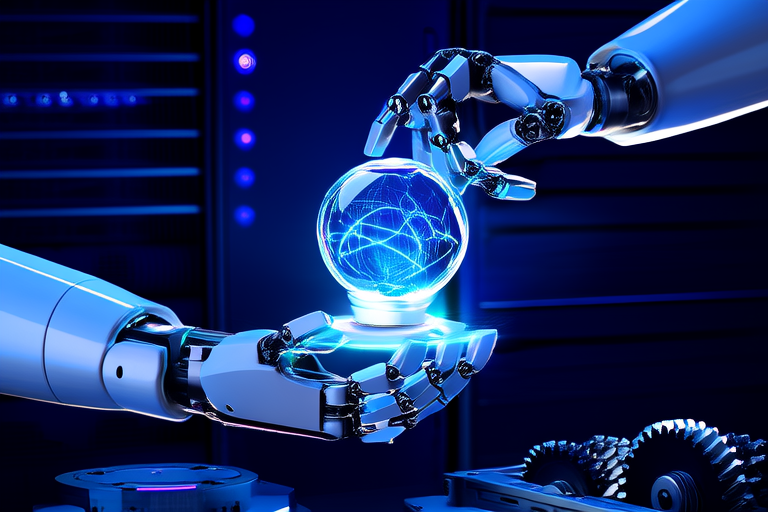The Intersection of AI and Innovation: Opportunities in Machine Learning
Artificial Intelligence (AI) has emerged as one of the most transformative technologies of our time, reshaping industries and driving innovation across the globe. From healthcare to finance, manufacturing to entertainment, AI is revolutionizing traditional processes and opening up new possibilities for growth and development. At the heart of this technological evolution lies machine learning (ML), a subset of AI that enables systems to learn from data and improve their performance over time without explicit programming. This article explores the intersection between AI and innovation, with a particular focus on the opportunities presented by machine learning.
Introduction
AI refers to the simulation of human intelligence in machines that are designed to think, learn, and act like humans. It encompasses a wide range of technologies, including natural language processing, computer vision, robotics, and machine learning. As AI continues to advance, it is becoming increasingly integral to various industries, offering solutions that were once considered impossible. Machine learning, a branch of AI, focuses on developing algorithms that allow computers to learn from and make predictions based on data. By leveraging large datasets and advanced computational power, ML models can identify patterns, make decisions, and automate tasks with remarkable accuracy.
The intersection of AI and innovation is significant because it fosters a dynamic environment where creativity and technology converge. AI provides the tools and capabilities necessary to push boundaries and explore new frontiers, while innovation ensures that these tools are applied effectively to solve real-world problems. Together, AI and innovation create a powerful synergy that drives progress and shapes the future.
The Role of AI in Innovation
AI is playing a pivotal role in driving innovation across numerous sectors, transforming industries and enhancing productivity. In healthcare, for instance, AI-powered diagnostic tools are helping doctors detect diseases at an early stage, improving patient outcomes and reducing costs. Machine learning algorithms analyze medical records, imaging scans, and genetic data to provide accurate diagnoses and personalized treatment plans. Similarly, in finance, AI is being used to develop sophisticated risk management systems, fraud detection mechanisms, and algorithmic trading strategies. These innovations not only streamline operations but also enhance decision-making processes, leading to more efficient and effective financial services.
The manufacturing sector is another area where AI is making significant strides. Through the integration of AI and robotics, manufacturers are achieving higher levels of precision and efficiency. Predictive maintenance systems powered by machine learning can anticipate equipment failures before they occur, minimizing downtime and maximizing productivity. Additionally, AI-driven supply chain optimization tools help companies manage inventory, forecast demand, and reduce waste, ensuring smoother operations and cost savings.
The impact of AI on traditional processes and workflows is profound. By automating repetitive and time-consuming tasks, AI frees up human resources to focus on more strategic and creative endeavors. This shift not only improves efficiency but also enhances job satisfaction and overall business performance. Moreover, AI’s ability to process vast amounts of data quickly and accurately allows organizations to gain deeper insights into customer behavior, market trends, and operational inefficiencies, enabling them to make informed decisions and stay competitive in an ever-evolving marketplace.
Opportunities in Machine Learning
Machine learning presents a plethora of opportunities that are reshaping industries and creating new possibilities for innovation. One of the most promising areas is predictive analytics, which involves using historical data to forecast future trends and outcomes. By analyzing patterns and correlations in large datasets, ML models can predict customer preferences, market demands, and even potential risks. For example, e-commerce platforms use predictive analytics to recommend products tailored to individual users, increasing sales and customer satisfaction. Financial institutions leverage ML algorithms to assess creditworthiness and manage investment portfolios, optimizing returns and minimizing risks.
Automation is another key opportunity offered by machine learning. As businesses strive to become more efficient and agile, automating routine tasks becomes essential. ML-powered robots and software agents can perform repetitive tasks with high precision, freeing up human workers to focus on more complex and creative activities. In the logistics industry, autonomous vehicles and drones equipped with ML algorithms are revolutionizing transportation and delivery processes, reducing costs and improving service quality. Furthermore, chatbots and virtual assistants powered by natural language processing enable organizations to provide round-the-clock customer support, enhancing user experience and engagement.
Personalized experiences represent yet another exciting opportunity presented by machine learning. By analyzing user data, ML models can tailor content, products, and services to individual preferences and needs. In the entertainment industry, streaming platforms use ML algorithms to curate personalized playlists and movie recommendations, keeping users engaged and satisfied. Retailers employ ML-driven recommendation engines to suggest relevant products based on browsing history and purchase behavior, boosting sales and customer loyalty. Personalization not only enhances user experience but also fosters deeper connections between brands and consumers, driving long-term success.
While the opportunities presented by machine learning are vast, there are also potential challenges and barriers to adoption. One of the primary concerns is data privacy and security. As ML models rely heavily on large datasets, ensuring the protection of sensitive information becomes crucial. Organizations must implement robust security measures and comply with regulatory requirements to safeguard user data. Another challenge is the need for skilled professionals who can design, develop, and deploy ML models effectively. The demand for talent in this field far exceeds the available supply, creating a skills gap that hinders widespread adoption. Additionally, ethical considerations surrounding AI and ML, such as bias and fairness, must be addressed to ensure responsible and equitable use of these technologies.
Future Prospects
The future of AI and machine learning holds immense promise, with continuous advancements expected to further enhance innovation and drive progress. Emerging trends such as edge computing, quantum computing, and federated learning are poised to shape the landscape of AI and ML, offering new possibilities and challenges. Edge computing, for instance, allows ML models to run locally on devices rather than relying on centralized servers, improving latency and privacy. Quantum computing, with its ability to process complex calculations exponentially faster than traditional computers, could revolutionize fields like cryptography, drug discovery, and material science. Federated learning enables multiple parties to collaboratively train ML models without sharing raw data, preserving privacy while improving model accuracy.
As AI and ML continue to evolve, it is important to consider the ethical implications and societal impacts of these advancements. Ensuring fairness, transparency, and accountability in AI systems is crucial to building trust and promoting responsible innovation. Organizations must prioritize diversity and inclusion in data collection and model training to avoid perpetuating biases and inequalities. Additionally, fostering collaboration between stakeholders—industry, academia, government, and civil society—is essential to addressing ethical challenges and harnessing the full potential of AI and ML for the benefit of all.
Conclusion
In conclusion, the intersection of AI and innovation offers a wealth of opportunities for growth and development across various industries. Machine learning, as a core component of AI, plays a vital role in driving innovation by enabling predictive analytics, automation, and personalized experiences. While challenges exist, such as data privacy, skill shortages, and ethical considerations, the transformative potential of AI and ML is undeniable. As we move forward, it is crucial to embrace these technologies responsibly, ensuring that they are used to create positive change and enhance the quality of life for everyone. We encourage readers to explore further opportunities in this rapidly evolving field and contribute to shaping a brighter future through innovation and technology.




